Service history
Although reportedly completed on 5 December 1917, [2] she was listed as being commissioned on 15 November 1917, [3] prior to her completion. In December 1917, she was assigned to the 13th Destroyer Flotilla [4] in the Grand Fleet. [5]
In early June 1918, Vectis conducted towing trials with the NS-class airship N.S.3 to see if an airship which ran out of fuel or suffered a mechanical breakdown could be towed at speed by a ship at sea. Trials were successful, with Vectis reaching nearly 20 knots (37 km/h; 23 mph) with N.S.3 in tow. Before the final run, N.S.3 landed on the sea to exchange two officers from Vectis for two of her own crew. [6] [7]
After the armistice with Germany of 11 November 1918 brought World War I to an end, Vectis was incorporated into a new 3rd Destroyer Division, 2nd Destroyer Flotilla, in the spring of 1919. With the new formation, she took part during 1919 in the British campaign in the Baltic Sea against Bolshevik forces during the Russian Civil War.
Vectis was among the ships which accompanied the battlecruisers HMS Hood and HMS Tiger during their visit to Scandinavian ports in June 1920. During the voyage, she and the destroyer HMS Vega tested the Royal Navy's High Speed Mine Sweep, which the British Admiralty hoped to use in the shallow waters of the Baltic in the event of a war with Bolshevik Russia (soon to become the Soviet Union). In a blow to the Admiralty's plans, both destroyers lost their minesweeping apparatus, demonstrating the High Speed Mine Sweep to be impractical in shallow water. [8]
Vectis recommissioned on 27 August 1920. [9] In 1921, she joined the light cruisers HMS Caledon, HMS Castor, HMS Cordelia, and HMS Curacoa and the destroyers HMS Vanquisher, HMS Venetia, HMS Viceroy, HMS Violent, HMS Viscount, HMS Winchelsea, and HMS Wolfhound in a Baltic cruise, departing the United Kingdom on 31 August 1921. The ships crossed the North Sea and transited the Kaiser Wilhelm Canal to enter the Baltic, where they called at Danzig in the Free City of Danzig; Memel in the Klaipėda Region; Liepāja, Latvia; Riga, Latvia; Tallinn, Estonia; Helsinki, Finland; Stockholm, Sweden; Copenhagen, Denmark; Gothenburg, Sweden; and Kristiania, Norway, before crossing the North Sea and ending the voyage at Port Edgar, Scotland, on 15 October 1921. [10]
Vectis recommissioned at Devonport on 4 December 1923. On 21 January 1925, she took part with Royal Air Force bombers, the light cruisers Caledon, HMS Calliope, HMS Carysfort, and Curacoa, the battlecruisers Hood and HMS Repulse, and the battleships HMS Ramillies, HMS Resolution, HMS Revenge, HMS Royal Oak, and HMS Royal Sovereign in sinking the decommissioned battleship HMS Monarch as a target 50 nautical miles (93 km; 58 mi) south of the Scilly Isles, firing her 4-inch (102-mm) guns at Monarch. By March 1925 she was operating as part of the 9th Destroyer Flotilla in the Atlantic Fleet. [11] She recommissioned with a reserve crew on 23 November 1925. [12]
Vectis recommissioned on 31 January 1927 for service with the 7th Destroyer Flotilla in the Atlantic Fleet. [13] She underwent a re-tubing of her boilers at Sheerness Dockyard, and it was completed on 1 March 1927. [14] She again recommissioned on 1 April 1928. [15]
Final disposition
After World War I, the United Kingdom received the passenger liner SS Bismarck from Germany in 1920 as a war reparation, and she was sold to the White Star Line, later the Cunard White Star Line, in which she served as RMS Majestic. In 1936, Cunard White Star retired Majestic and sold her to Thos. W. Ward for scrapping, but because of legal requirements imposed under the agreement transferring Majestic to the United Kingdom as a war prize, the British government instead took control of Majestic and assigned her to the Royal Navy. To pay Thos W Ward for Majestic, the Royal Navy agreed to transfer 24 old destroyers with a combined scrap value equivalent to that of Majestic to Thos. W. Ward for scrapping. Vectis was among these, and her transfer to Thos W Ward for scrapping took place on 25 August 1936. She was scrapped at Inverkeithing, Scotland. [2]

HMS Castor was one of the Cambrian subclass of the C class of light cruisers. She saw service during the First World War and the Russian Civil War.

HMAS Vendetta (D69/I69) was a V-class destroyer that served in the Royal Navy and the Royal Australian Navy (RAN). One of 25 V class ships ordered for the Royal Navy during World War I, Vendetta entered service in 1917.

HMS Seafire was an S-class destroyer built for the Royal Navy during the First World War. She saw service during the Allied intervention in the Russian Civil War. The ship was sold for scrap in 1936.
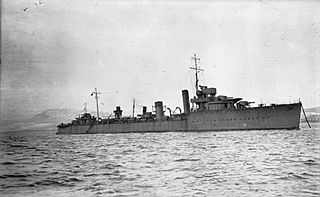
HMS Warwick (D25) was an Admiralty W-class destroyer built in 1917. She saw service in both the First and Second World Wars, before being torpedoed and sunk in February 1944.

The fourth HMS Cleopatra was a C-class light cruiser of the Royal Navy that saw service during World War I and the Russian Civil War. She was part of the Caroline group of the C class.
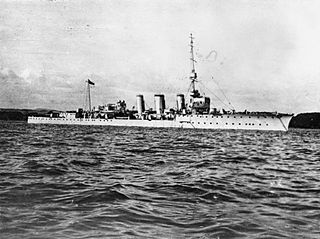
HMS Cordelia was a C-class light cruiser built for the Royal Navy during World War I. She was one of six ships of the Caroline sub-class and was completed at the beginning of 1915. The ship was assigned to the 1st and 4th Light Cruiser Squadrons (LCS) of the Grand Fleet for the entire war and played a minor role in the Battle of Jutland in mid-1916. Cordelia spent most of her time on uneventful patrols of the North Sea. She served as a training ship for most of 1919 before she was recommissioned for service with the Atlantic Fleet in 1920. The ship was placed in reserve at the end of 1922 and was sold for scrap in mid-1923.
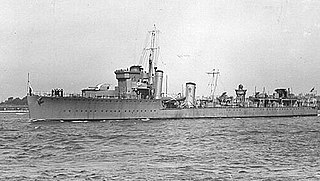
HMS Whitley (L23), ex-Whitby, was a W-class destroyer of the British Royal Navy that saw service in the British campaign in the Baltic Sea against Bolshevik forces during the Russian Civil War and in the early months of World War II.

HMS Vivacious (D36) was a V-class destroyer of the British Royal Navy that saw service in World War I and World War II.

The fifth HMS Valorous, ex-HMS Montrose, was a V-class flotilla leader of the British Royal Navy that saw service in World War I, the Russian Civil War, and World War II.

HMS Vanquisher (D54) was a V-class destroyer of the British Royal Navy that saw service in World War I and World War II.
HMS Violent was a V-class destroyer of the British Royal Navy that saw service in World War I and was in commission from 1917 to 1937.

HMS Venturous (D87) was a V-class destroyer of the British Royal Navy that saw service in World War I.

The second HMS Vega was a V-class destroyer of the British Royal Navy that saw service in World War I and World War II.
HMS Venetia (D53) was a V-class destroyer of the British Royal Navy that saw service in World War I and World War II.

The first HMS Walrus (D24) was a W-class destroyer of the British Royal Navy that saw service in the final months of World War I.
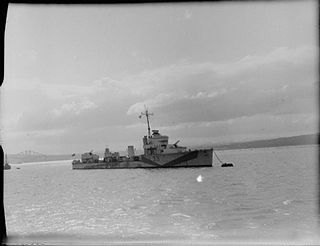
HMS Vivien (L33) was a V-class destroyer of the British Royal Navy that saw service in World War I and World War II.

HMS Viceroy (D91) was a W-class destroyer of the British Royal Navy that saw service in the final months of World War I and in World War II.

The eighth HMS Worcester, was a Modified W-class destroyer of the British Royal Navy that saw service in World War II. She later served as an accommodation ship as the second HMS Yeoman.
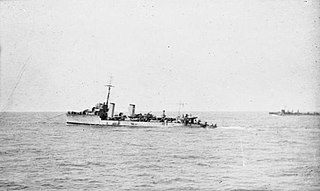
HMS Shakespeare was a Thornycroft type flotilla leader of the British Royal Navy. She was built by J I Thornycroft from 1916 to 1917 as the lead ship of her class, launching in July 1917 and completing in October 1917.
HMS Spenser was a Thornycroft type flotilla leader of the British Royal Navy. She was built by J I Thornycroft from 1916 to 1917 as the lead ship of her class, launching in September 1917 and completing in December that year.
This page is based on this
Wikipedia article Text is available under the
CC BY-SA 4.0 license; additional terms may apply.
Images, videos and audio are available under their respective licenses.

















